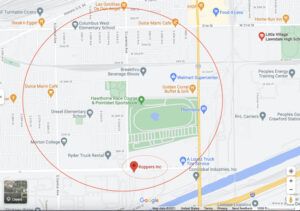Chicago’s Closest Cancer Hotspot is a Nearby Suburb
Less than a mile away from Drexel Elementary School is the biggest cancer-causing hotspot in the Chicago area. But it’s not located in the city. Instead, it’s in a nearby suburb, Cicero, Illinois.
Recently, the independent investigative journal, ProPublica, published “The Most Detailed Map of Cancer-Causing Industrial Air Pollution in the U.S.” Its interactive map lets you type in any address in the United States and see the nearest cancer hotspot. Surprisingly, in Chicago, the big cancer hotspot is caused by Kopper’s Inc., a global chemical and materials company in the western suburb of Cicero. The cancer risk? It’s 1 in 4,800. That’s more than double (2.1 times) the EPA’s acceptable risk. Kopper’s Inc. contributes nearly 97.5% of the estimated cancer risk in Cicero by emitting known carcinogens, such as polycyclic aromatic compounds, quinoline, naphthalene, and more. These chemicals have been found to cause lung cancer, which has the highest mortality rate in the United States. The factory is also near another elementary school, Columbus West, close to Morton College, a community college founded in 1924, a largely residential area, and, two miles away, Lawndale High School in Chicago proper.
So, why is this community burdened with environmental injustice? The most shocking revelation is that such hotspots areas are allowed by the EPA. Dubbed “Sacrifice Zones,” polluters have been given the green light to force residents in neighborhoods like Cicero to inhale carcinogens on a daily basis. Cicero, Illinois, is a majority Hispanic community, with 89.6% of the population identifying as Hispanic or Latinx; 80.2% of the population is of Mexican descent. This is a tragic instance of environmental racism, leading to the exposure of an entire community to increased cancer risk, polluted air, and an unhealthy environment. One must ask if this would happen elsewhere, specifically, a white, wealthy neighborhood? Evanston is another suburb on the edge of Chicago, much like Cicero. However, it is on the opposite end of the city, towards the North side. The population there is wealthy, with a majority white population. These two areas are opposites geographically and demographically. As you might expect, there isn’t a cancer hotspot in or near Evanston. The City of Chicago conducted a study that aligns with these findings:
“… the areas of greatest concern are primarily located on the South and West Sides of the city. In particular, parts of the city bisected by major highways with high concentrations of industry are overburdened, experiencing high levels of both pollution and vulnerability.”
The South and West sides of Chicago are low-income, minority areas. Like Cicero, these areas are burdened with environmental injustices that would not be allowed to occur in wealthier, predominantly white neighborhoods. Cicero residents are acutely aware of this marginalization and the risks they are at in their community. “We know the air isn’t good here, but what can we do? I can’t just move away, where would I even go? I can’t afford that.” says one Cicero resident.
Since the groundbreaking 1987 report, Toxic Waste and Race in the United States, a number of studies have found that pollution is segregated. People of color are exposed to higher levels of toxic wastes and air pollution, as opposed to their white counterparts – regardless of income level. This can be tied back to racist real estate practices like redlining and designating communities of color as mixed-residential industrial zones.
Cicero and communities like it do not have the resources of wealthier neighborhoods, i.e. health care and political power that could be used to fight against polluting companies. Companies like Koppers Inc. depend on vulnerable areas to act as unofficial dumpsites for their economic benefit.
How can we fix this? How can we ensure that everyone, especially our most vulnerable, have access to clean air? Improving zoning laws in these areas, to prevent more Koppers Inc. from moving in should be the first step. These communities also need an influx of resources to help combat the illnesses that many of them have and, unfortunately, will get. Stricter environmental regulations and reversal of Trump-era loosening of environmental regulations are also key to promoting environmental justice in vulnerable communities. The Build Back Better package that has been stymied by Sen. Joe Manchin (D-WVA) focuses on and promotes environmental justice. It still must be passed in some form. We hope to see states use the funding from it and the infrastructure package to help communities like Cicero. They must not be left behind again.
To find the nearest cancer hotspot in or near your community,
check out ProPublica’s Map here.
 RCC Fellow — Jennifer Coronel — Northwestern University
RCC Fellow — Jennifer Coronel — Northwestern University
Jennifer is a recent graduate of the University of Illinois at Urbana-Champaign with a Bachelor of Science in Natural Resource and Environmental Sciences with a concentration in Human Dimensions, along with two minors in Sustainability and Business. She is pursuing her Master of Science in Energy and Sustainability at Northwestern University.
![]() The Rachel Carson Council depends on tax-deductible gifts from concerned individuals like you. Please help if you can.
The Rachel Carson Council depends on tax-deductible gifts from concerned individuals like you. Please help if you can.
![]() Sign up here to receive the RCC E-News and other RCC newsletters, information and alerts.
Sign up here to receive the RCC E-News and other RCC newsletters, information and alerts.

